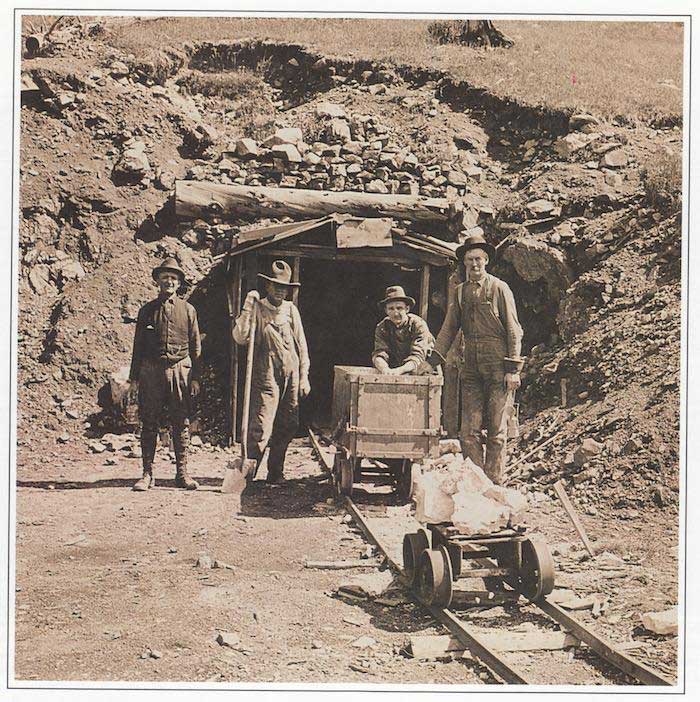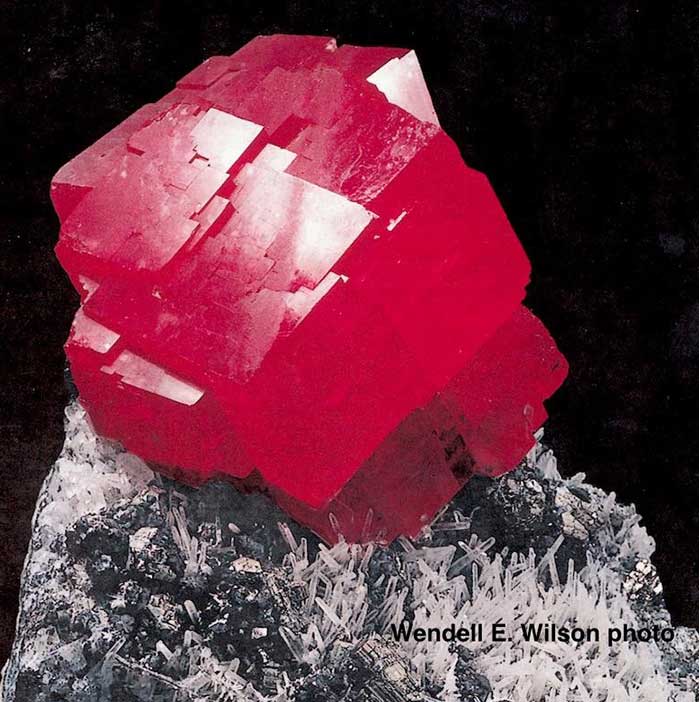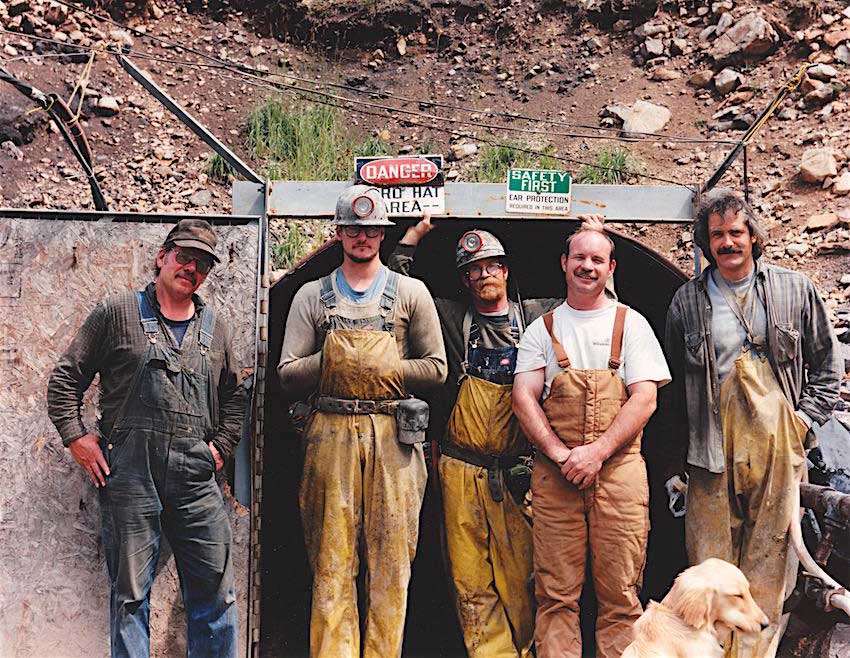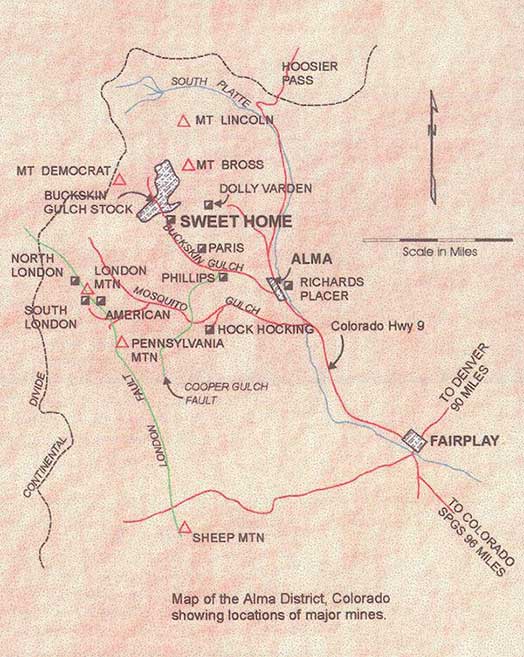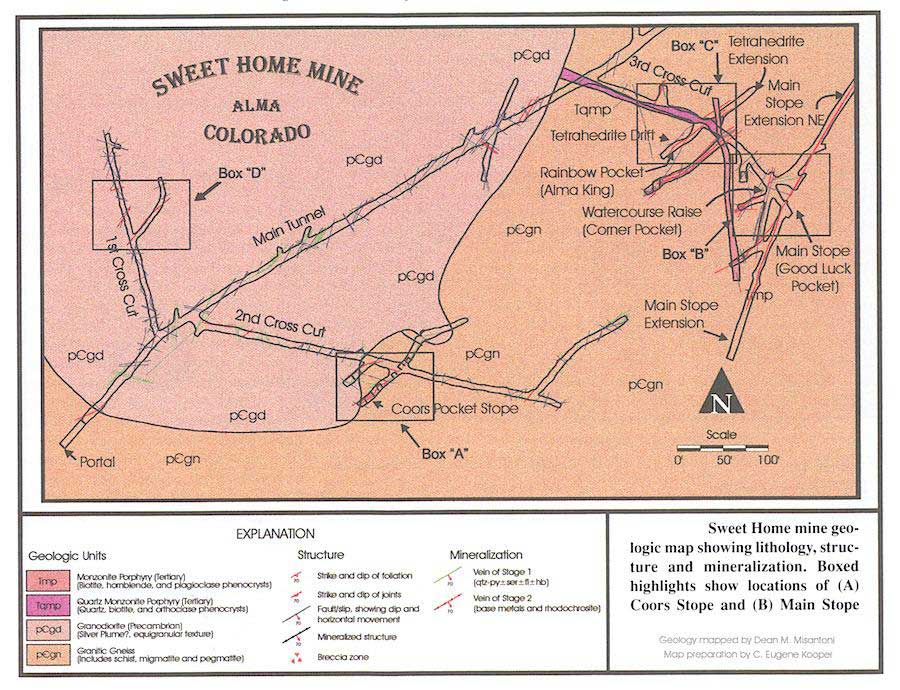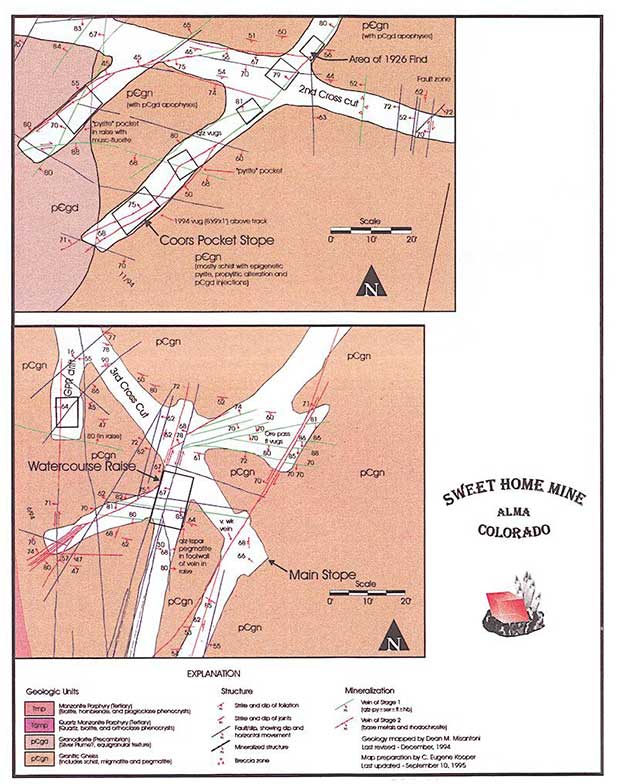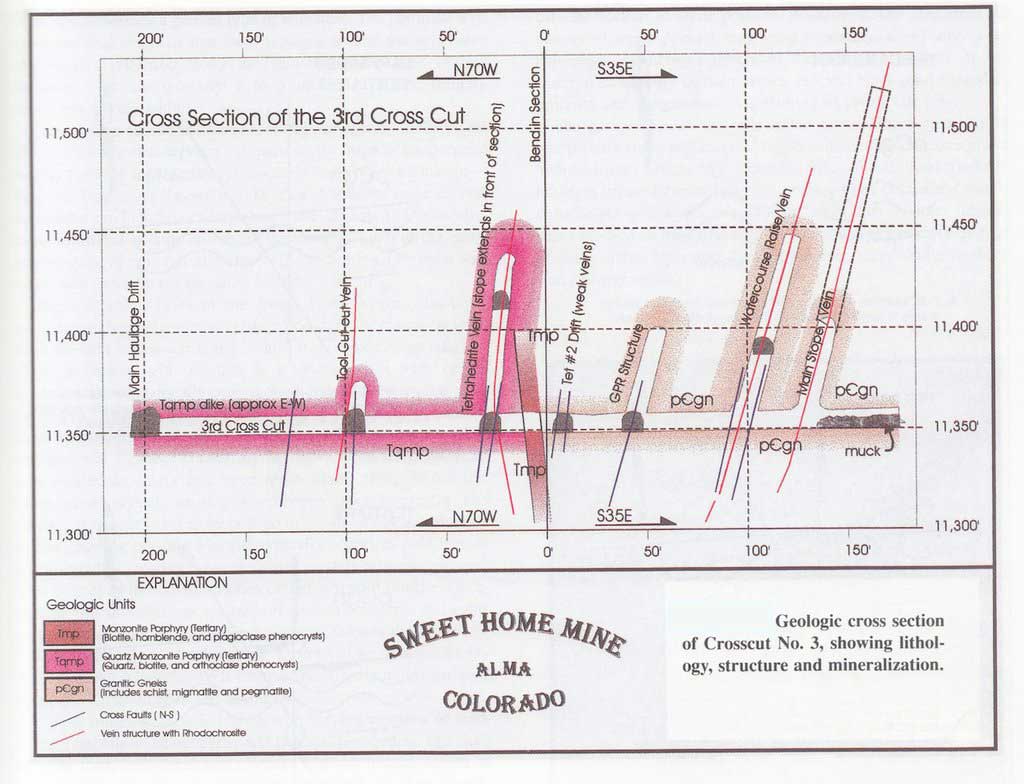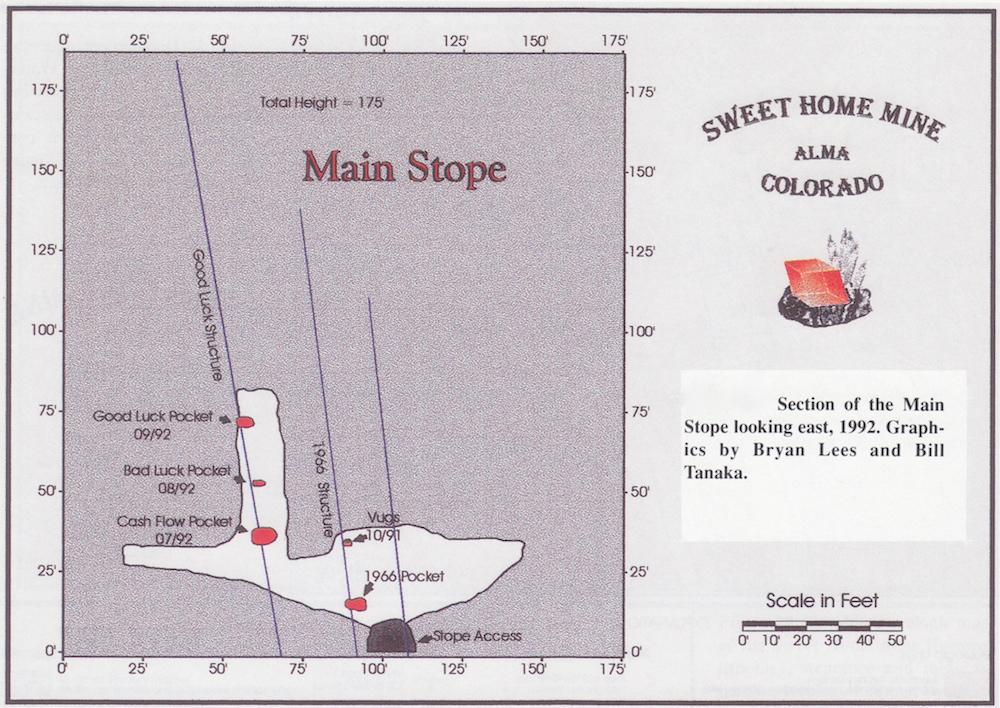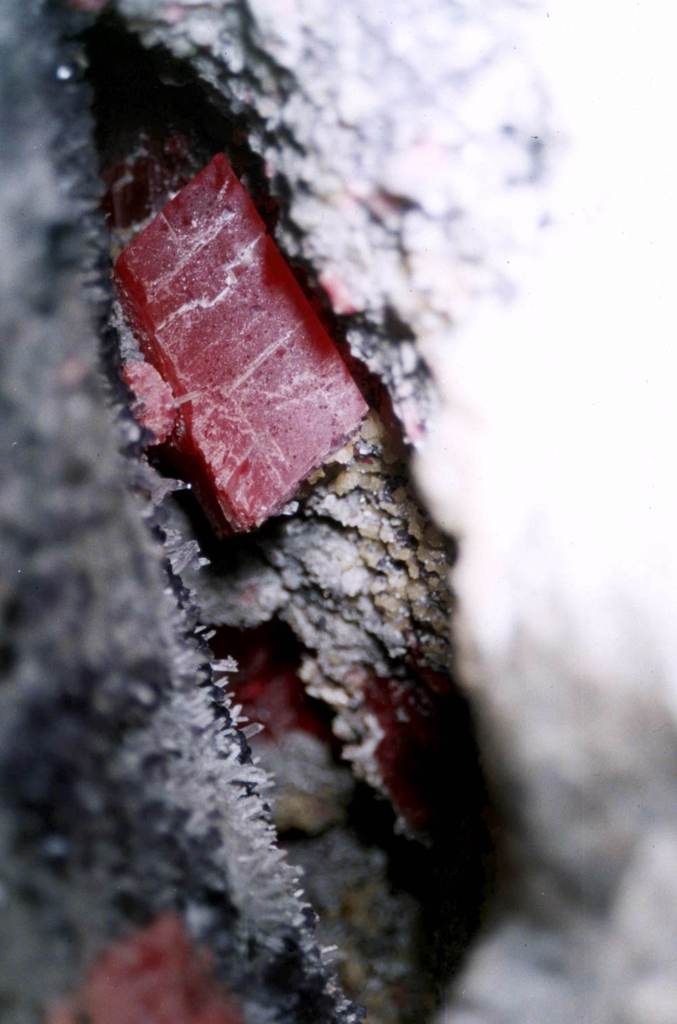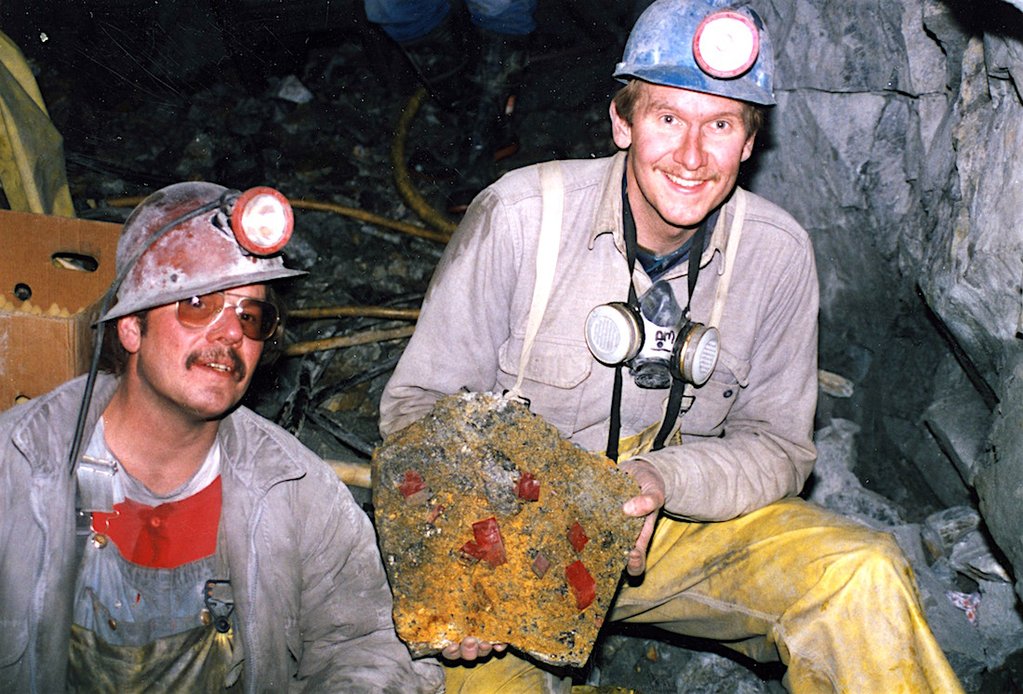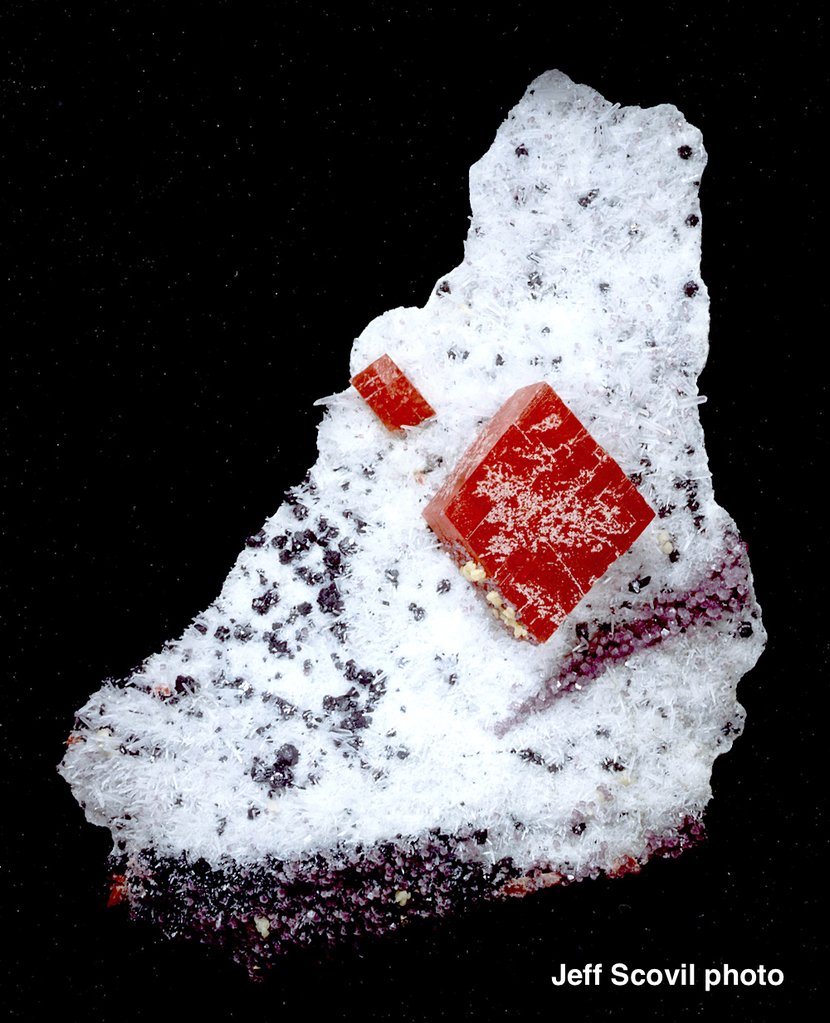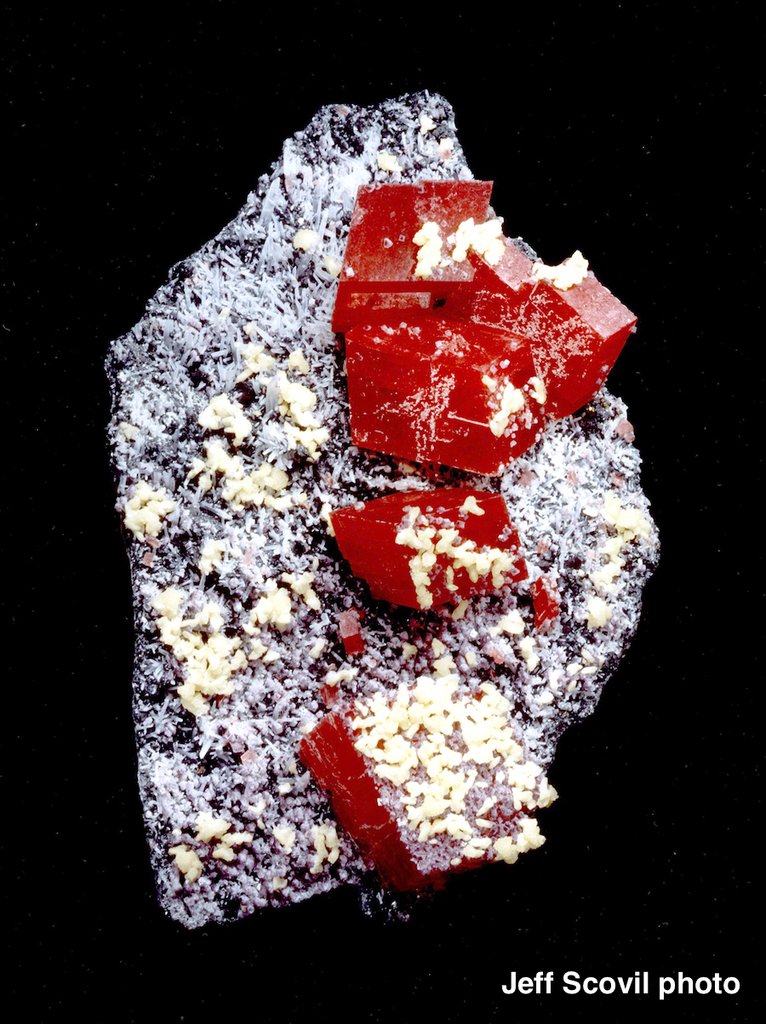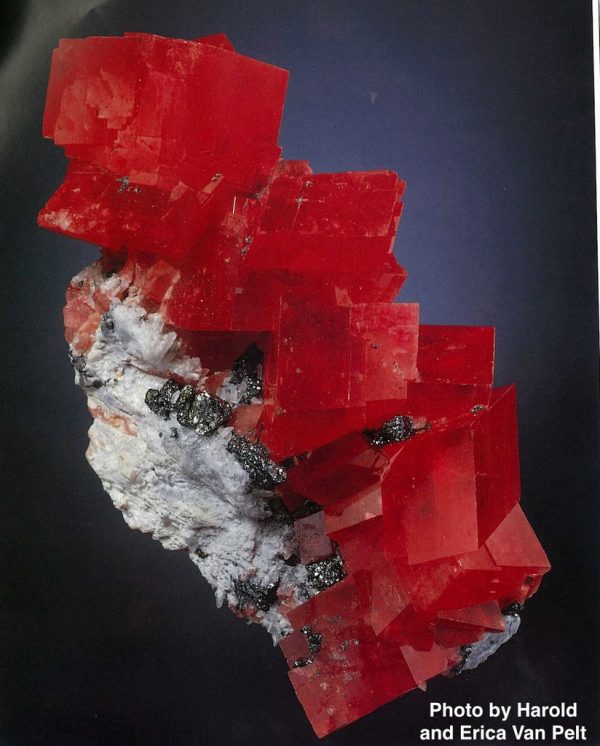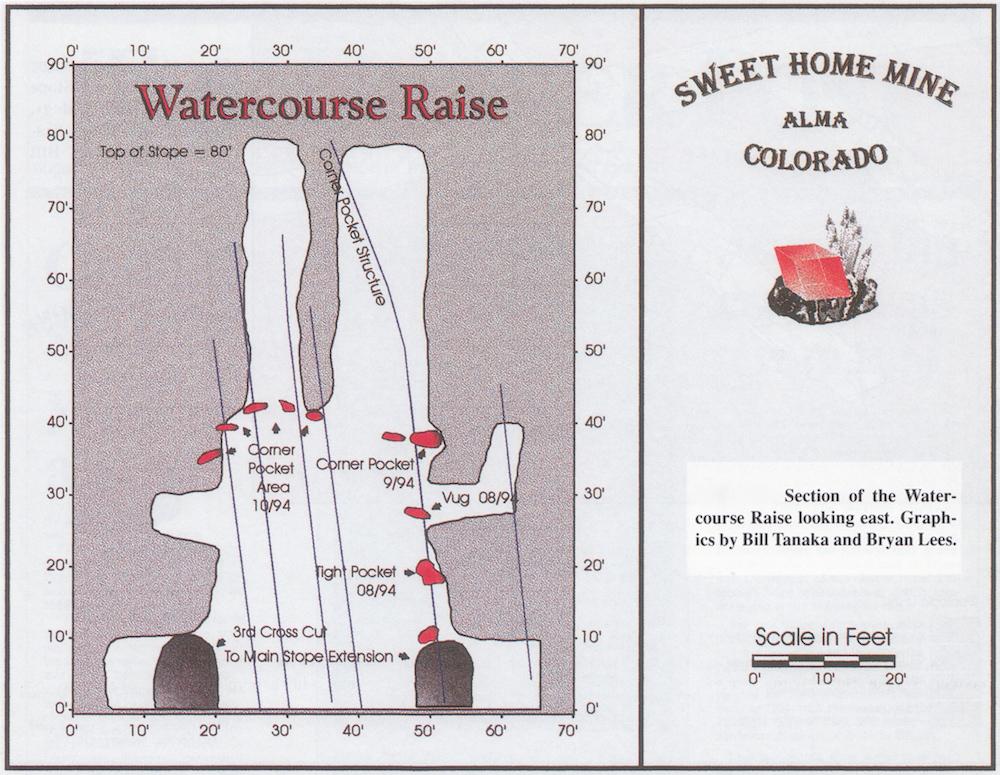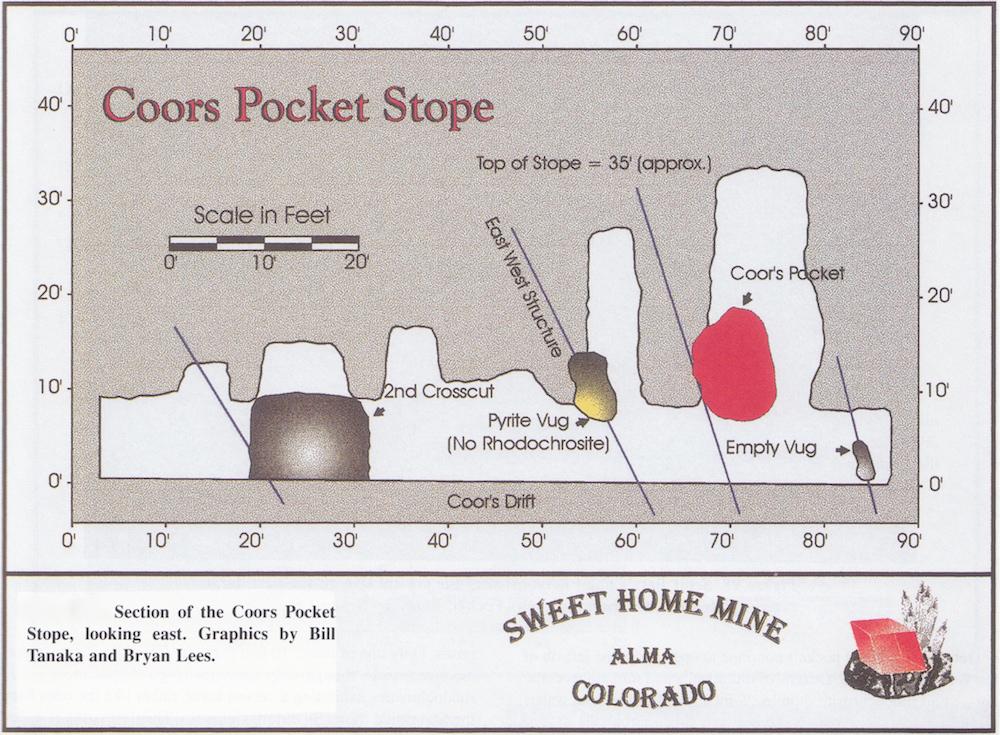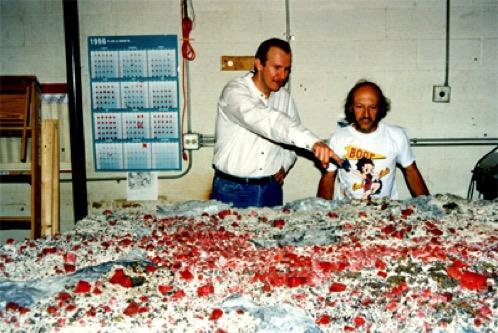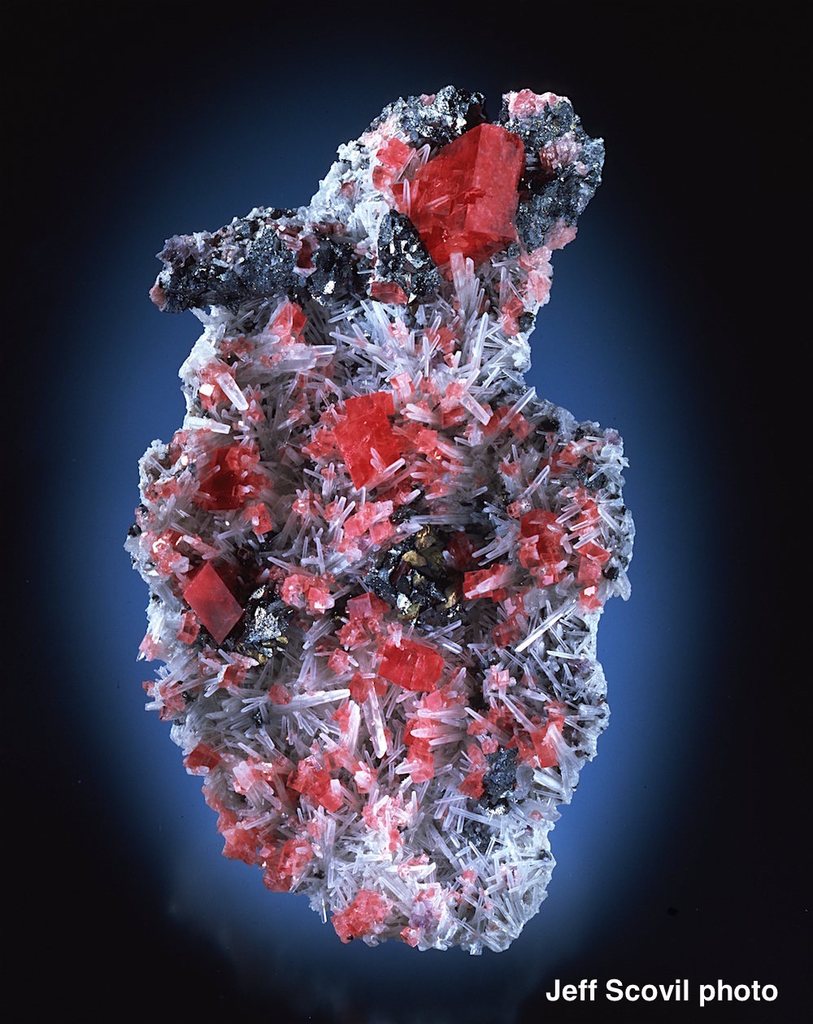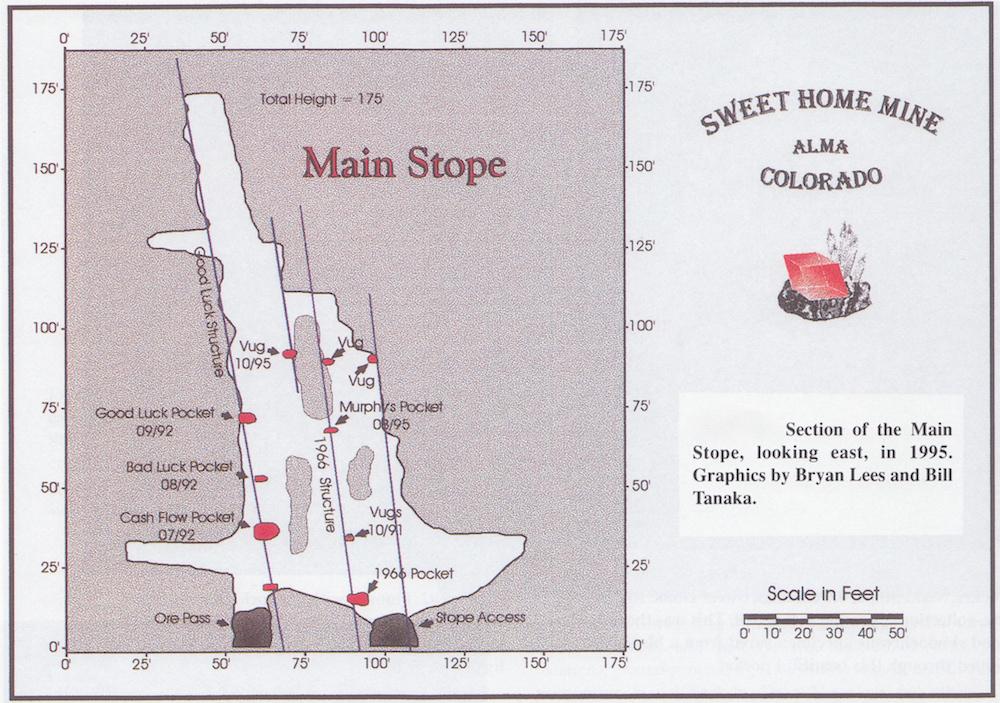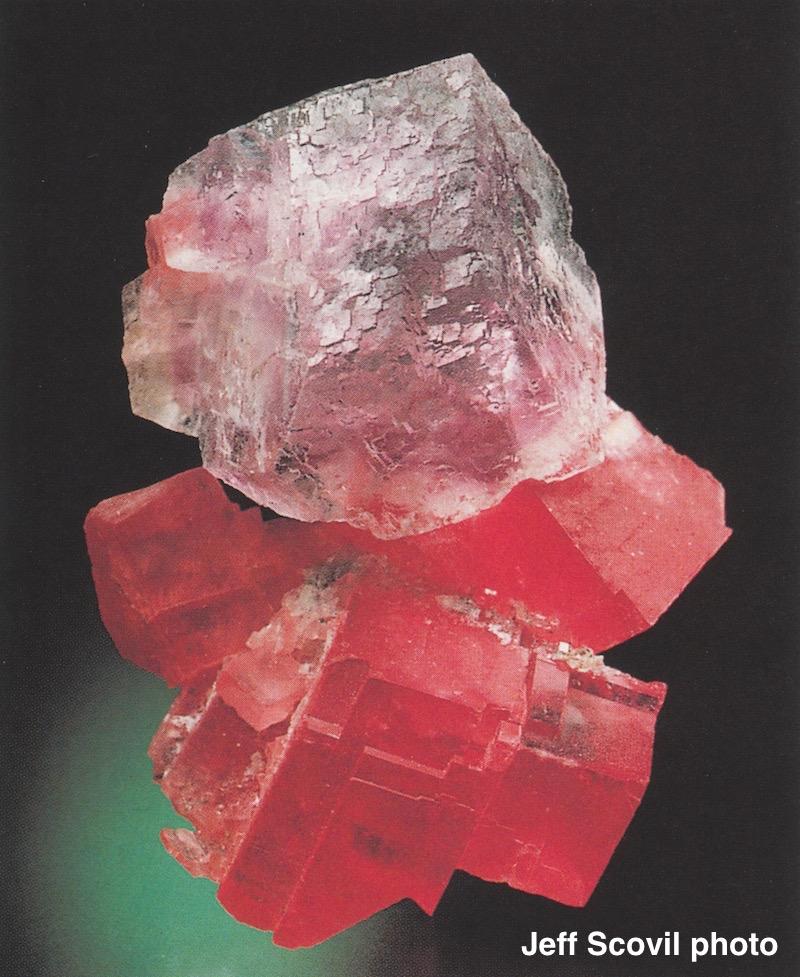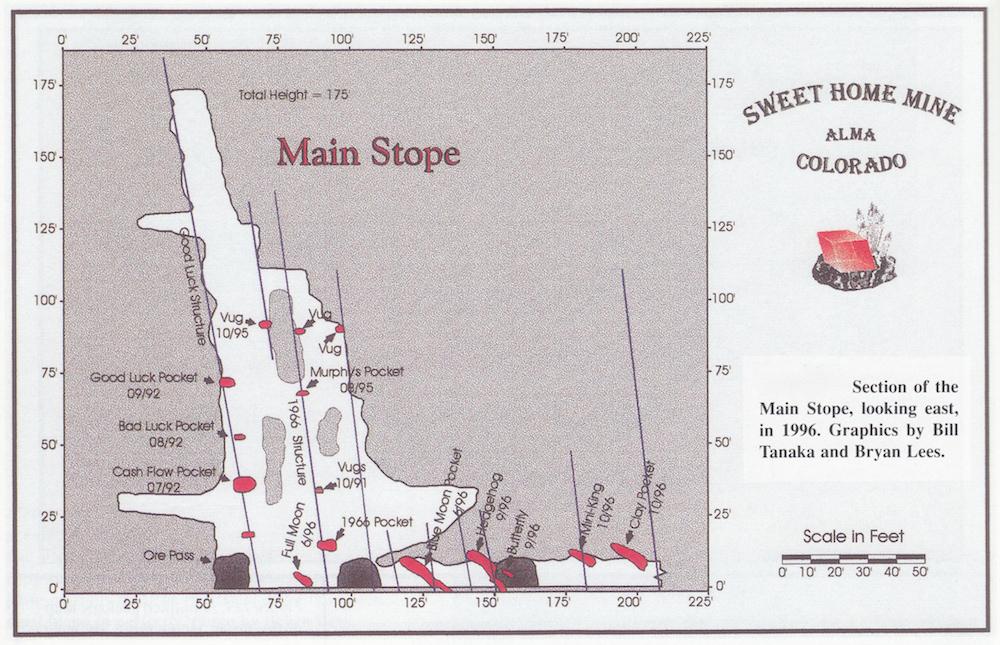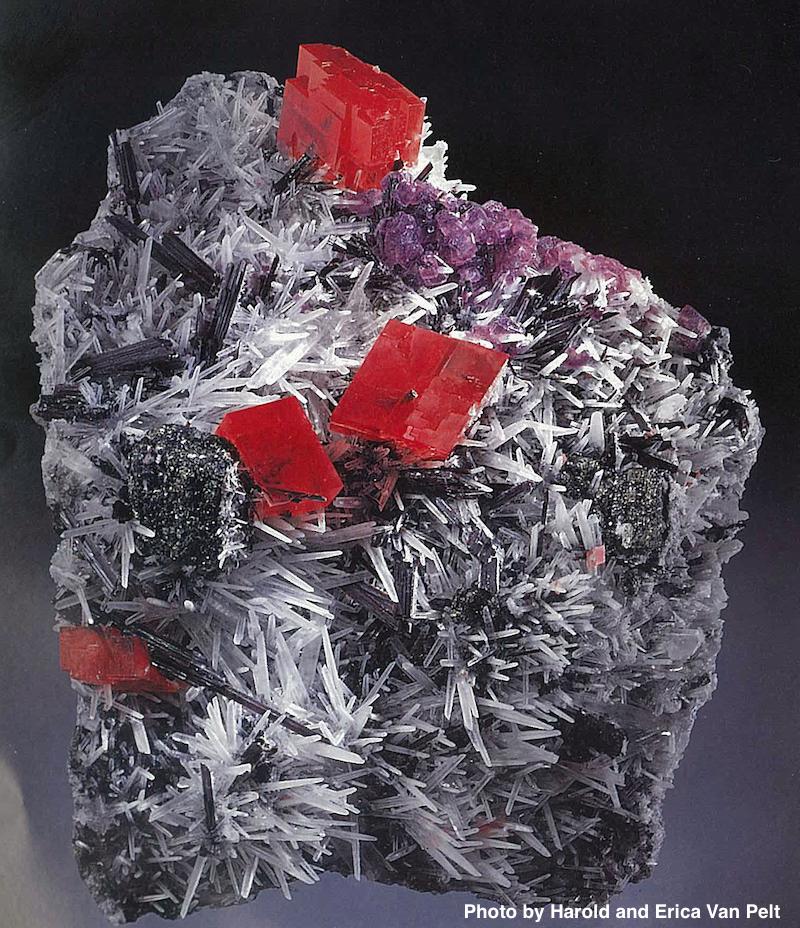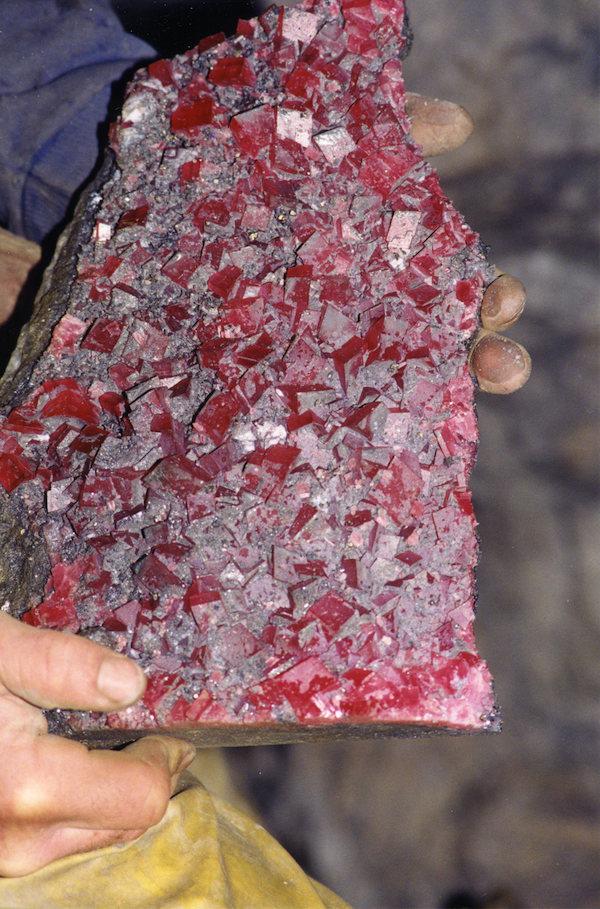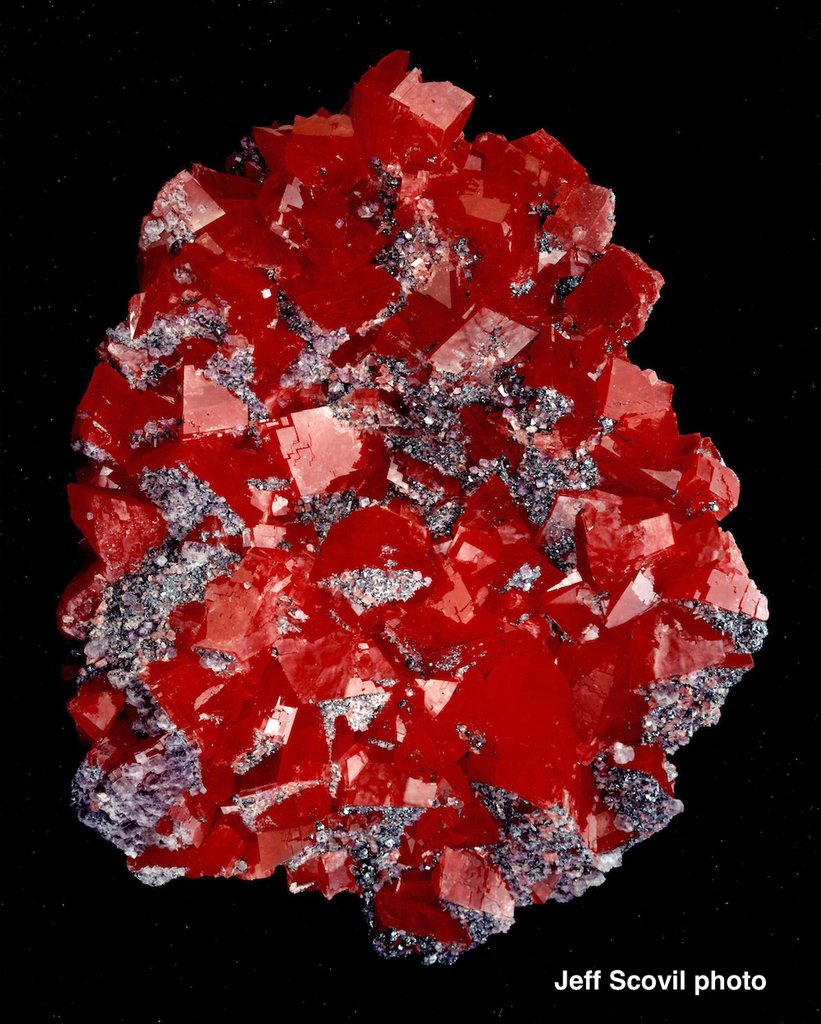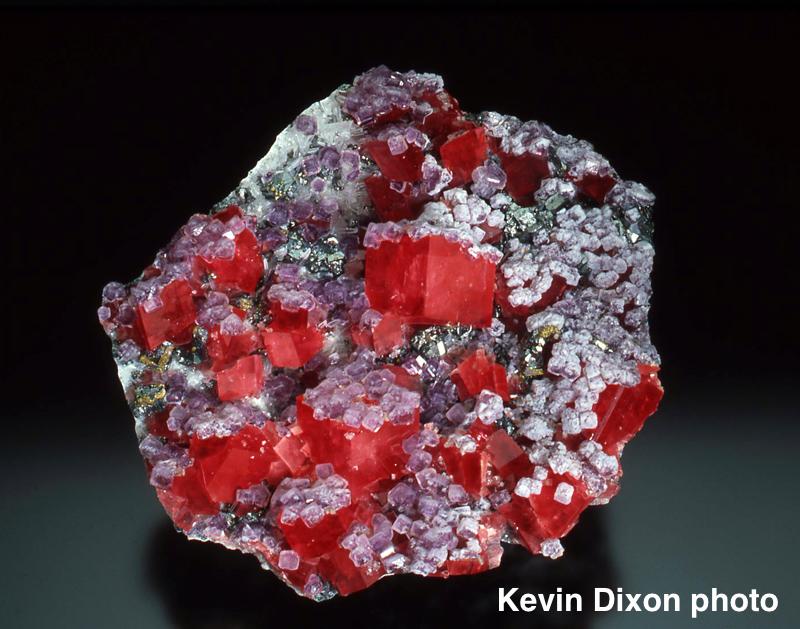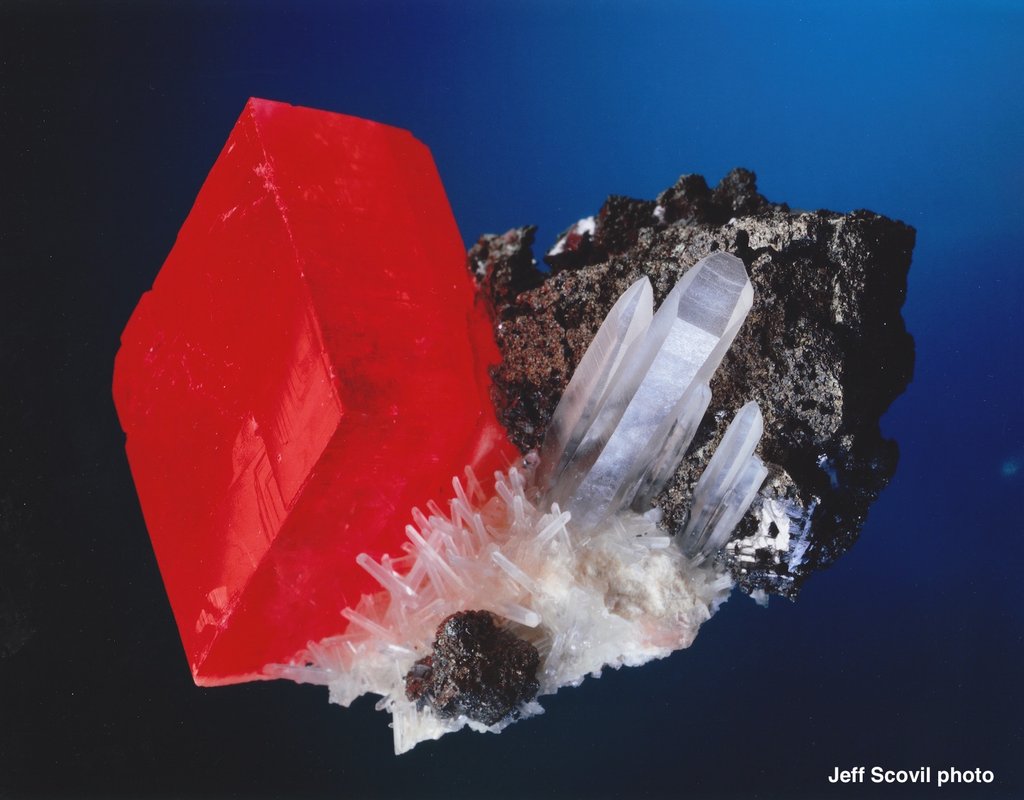Introduction
The Sweet Home Mine has produced many of the world’s best rhodochrosite specimens. It’s bright red color and gemmy interior place this mineral among the most desirable of all mineral species. In 1991 Bryan and Kathryn Lees, of Collector’s Edge Minerals, Inc., and several key investors, entered into a leasing agreement with the Sweet Home mine owner, Leonard Beach, to operate and mine the Sweet Home over the next several years, under the name “Sweet Home Rhodo, Inc.”. This enterprise would lead to the unprecedented discovery of the world’s finest rhodochrosite specimen, the “Alma King”, and many other world-class specimens. The “Alma King” and the “Crystal Wall”, a 7-foot by 8 foot reconstructed pocket, sprinkled with hundreds of deep red, translucent rhodochrosite crystals from the Sweet Home mine, now reside in the Denver Museum of Natural History.
Collector’s Edge Minerals, Inc. recognizes and thanks the Mineralogical Record for permission to use portions or all of their original article found in the Mineralogical Record, July-August, 1998, Volume 29, Number 4.
Location
The Sweet Home mine is located in the Alma mining district on the eastern slope of central Colorado’s Mosquito Range. The mine is located about 90 miles southwest of Denver, Colorado, near the small mountain town of Alma. The district, near the headwaters of the South Platte River, is one of North America’s highest mining districts, includes several 14,000-foot peaks; most of its mines are at or well above the 1,300-foot timberline. The Sweet Home mine is actually one of the district’s lower mines, located near the timberline in Buckskin Gulch on the southern slope of Mount Bross, 4.5 miles west of Alma.
History
As silver mines go, the Sweet Home mine was a failure. It was a hole in the ground that devoured hopes and money, and gave very little in return. Based solely on its unimpressive silver output, the Sweet Home should have faded into obscurity and abandonment a century ago, joining many others that became nothing more than collapsed portals and flooded workings. However, if the Sweet Home didn’t have much silver, it did indeed have a stubborn ability to survive.
Discovered in 1873 and developed for its silver ore, the Sweet Home mine became known for strikingly beautiful, red rhodochrosite crystals, which are acknowledged as the world’s finest. The mine was intermittently worked with moderate success as a silver mine before it closed in 1967. In 1991, it was reopened, not as a silver mine, but as a rhodochrosite specimen mine. For the next fourteen years, the mine produced rhodochrosite specimens, many of which now grace the world’s finest museums and private mineral collections. lts enduring impact on the mineral collecting community has earned Sweet Home rhodochrosite top honors.
In 1861, gold fever was driving prospectors deeper and deeper into the Rocky Mountains as they attempted to follow placer gold deposits to their hard rock sources. As prospectors searched the Alma area, they discovered rich silver lodes—the largest yet found in the state—high on Mt. Bross and immediately began to develop them. By 1871, prospectors had made their way up Buckskin Gulch, northwest of Alma, and in 1873, they discovered the Sweet Home and Pulaski lodes at the base of Mt. Bross. The early miners thought the silver veins high on Mt. Bross might continue into the mountain’s core. To intersect the projections of the veins, miners drove the original Sweet Home mine tunnel 800 meters straight into the base of the mountain. While this exploration yielded little silver, it played a large role in the later development of the mine as a producer of specimen-quality rhodochrosite. The Sweet Home mine operated intermittently for more than ninety years as each successive owner continued to prospect for silver with the hope that the next blast would strike it rich.
The limited ore production was not adequate to sustain extended mining efforts, but throughout its history, sufficient rhodochrosite specimens were saved to make the Sweet Home mine famous among collectors. In fact, by the late 1880s, numerous Sweet Home rhodochrosite specimens had found their way into the great museum collections in the eastern United States.
The mine closed after the price of silver collapsed in 1893. The next significant mining activity occurred in the 1920s when Edwin Spray, a Denver entrepreneur, bought and reopened the Sweet Home mine. A spectacular pocket of rhodochrosite—the first of its kind to be documented at the Sweet Home mine—was discovered in 1926 while Spray’s team was working in the second crosscut area of the mine. A Colorado Springs mineral dealer purchased all of the specimens for the princely sum of $900 (Beach, 1991).
Sweet Home mine crew showing ore samples at portal. Joe Kasel on the left; ca. 1922. Photographer unknown.
Spray kept his vision of finding a silver bonanza alive until his death in 1964. The mine then passed to his widow, Eleanor Bramkamp Spray, who in turn passed the property to her nephew Leonard Beach. John Soules, a Texan, leased the mine during this period. In late 1966, Soules’ crew drilled into a pocket of specimens that would redefine collector-quality rhodochrosite. The now famous Alma Queen, later proclaimed the world’s finest mineral specimen, was among the specimens in Soules’ pocket. In 1967, Denver mineral collectors George Robertson and Merle Reid purchased the Alma Queen for $2,500 (Robertson, 1996). It was traded through some of the country’s finest mineral collections and was eventually sold to Texas oilman Perkins Sams. Sams later sold his collection, including the Alma Queen, to the Houston Museum of Natural Science, where it remains today.
Despite the strong and permanent market demand for rhodochrosite specimens inspired by the discovery of the Alma Queen, silver prices were simply too low and the ore too low grade to warrant continued production. The mine closed in 1967, marking its end as a silver mine. Un-swayed, Leonard Beach worked for the next twenty years to convince someone to reopen Sweet Home.
In the 1970s and 1980s, interest in mineral collecting grew increasingly strong, with prices for fine mineral specimens beginning to skyrocket, and the demand for rhodochrosite became insatiable. Most collectors wanted a fine Sweet Home rhodochrosite, but there was simply no supply. During this period, many people prospected the Sweet Home property. Two were successful. In January 1977, Norm and Roger Bennett located a fine pocket of rhodochrosite near the front of the mine, with the pocket producing at least six excellent specimens. Later that same year, a group led by Richard Kosnar leased the mine and found another nice, small pocket containing a few top-quality specimens.
Owing to the continued demand, by the late 1980s Leonard Beach had begun work on a plan to reopen the Sweet Home mine for rhodochrosite as well as for silver ore. Unbeknownst to him, a similar plan was being considered by another group: Bryan and Kathryn Lees of Golden, Colorado, were trying to convince a group of investors that the Sweet Home mine could yield great mineral specimens, enough to economically justify the expense of a mining operation. The Lees’ group incorporated under the name Sweet Home Rhodo, Inc.; Beach and the newly formed company finalized a lease agreement. In 1991, Sweet Home Rhodo, Inc. reopened the Sweet Home mine as a rhodochrosite mine, not a silver mine.
In 1998 Bryan and Kathryn Lees bought out the other investors and purchased the mine from Leonard Beach. The rest is history. The spectacular rhodochrosite specimens that Bryan and Kathryn Lees and their mine crew recovered during the l990’s have received worldwide publicity. The cumulative value of the rhodochrosite specimens recovered from the Sweet Home mine over the years probably exceeds $100 million, and the mine is clearly the world’s premier source of fine rhodochrosite. All in all, that’s not a bad record for a “failed” silver mine.
Geology
General Geology
The Alma mining district lies along the eastern slope of the northern portion of the Mosquito Range near the small town of Alma, in Central Colorado. The district has a long history of gold, silver, lead, copper and zinc production dating from pre-1850’s Spanish gold prospecting to the present. A wide variety of deposit types are present, of which the Sweet Home mine type is perhaps the most mineralogically unusual occurrence. Recent mining activity in the area (1980’s until present) has centered on: (1) gold production from veins at the gold-rich London sub-district, (2) Placer gold production from glacial, colluvial and alluvial gravels, and (3) rhodochrosite and associated mineral specimen mining from the Ag-base metal veins of the Sweet Home mine area.
The Mosquito Range is a north-south trending range consisting of gently east-dipping Cambrian through Pennsylvanian sedimentary rocks. This package of sedimentary rocks overlies Precambrian igneous and metamorphic rocks and represents the eastern limb of the Sawatch Anticline, which dips into the South Park Basin. The region has been intruded by a variety of Laramide to Tertiary igneous stocks, dikes, and sills. Thrust faults, reverse faults and normal faults have (1) offset the east-dipping sedimentary rocks and underlying Precambrian rocks, (2) locally controlled the emplacement of Tertiary igneous rocks and (3) controlled the locations of the diverse mineral deposit types.
Pleistocene glaciation and down cutting of the Mosquito, Buckskin, South Platte and other drainages created the deeply incised high central Mosquito Range. Such erosion liberated gold that created placers extending into South Park, east of Fairplay. More importantly for this study, the denudation of the range exposed the underlying Precambrian and younger igneous and metamorphic rocks that host the veins of the Sweet Home mine area.
The stratigraphic section of the Alma District contains Cambrian through Pennsylvanian limestone (presently all dolomite), quartzite, and shale deposited on an unconformable erosional surface on the Precambrian igneous and metamorphic rocks. Dioritic to quartz monzonitic intrusive rocks (possibly including some pegmatites) tend to occur as dikes and intrusive plugs in the Precambrian rocks and as sills in the overlying Paleozoic sedimentary formations.
Although the Paleozoic formations have hosted most of the precious and base-metal production of the district, the Sweet Home mine vein system is hosted by Precambrian and Tertiary intrusive rocks. A possibility exists that this vein system continues up dip into the Paleozoic units capping Mount Bross above the mine and to the east.
Several lines of evidence support a theory that the Alma district could be related to the hydrothermal system that formed the Climax deposit (about 8 km to the northwest of Sweet Home), or may be part of a separate Climax-type system. The most obvious of these features include: (1) ages of 28-31 million years (Ma) determined on early vein and wall rock hydrothermal muscovite (sericite) (Silberman, 1995), similar to those at Climax (Wallace. 1995), (2) the presence of pebble dikes or breccia in Buckskin Gulch, (3) scattered quartz-orthoclase pegmatite bodies (containing rare molybdenite) that are most likely Tertiary in age, (4) abundant amounts of fluorite, topaz and huebnerite (geochemically anomalous concentrations of Mn, Mo, F, W), (5) wall-rock alteration types including widespread quartz-sericite-pyrite, propylitic, and early stage fluorite-rich hydrothermal muscovite (associated with huebnerite-pyrite-quartz veins) greisen-type alteration, (6) isolated, thin quartz-pyrite MoS3 veins and local MoS2 coatings on fractures in the Sweet Home mine area, particularly in association with pegmatites, (7) isotopic evidence showing a magmatic component to the mineralizing fluids, and (8) a location near Climax and along the “Climax Line” described by Wallace (1995).
Local Geology
The Sweet Home mine is located at the base of Mount Bross, 6.4 km up from the mouth of Buckskin Gulch (at Alma) on the east side of Buckskin Creek. The mine was the most productive of several properties that were developed along the northeast and east-west trending swarm of Pb-Zn-Cu-Ag-W-bearing veins that extend across the gulch to the southwest and northeast above the mine on Mount Bross and into the Red Amphitheater. Mineralized rock extends up dip from the Sweet Home mine, to the northeast to near the unconformable contact of Precambrian with Paleozoic rocks. Examination of the underground workings at the Tanner Boy and Queen Mary mines on the west side of Buckskin Gulch confirmed the continuity of the vein swarm to the southwest. However, correlation of individual veins from the southwest to northeast across Buckskin Gulch is tenuous.
The surface geology of the area was mapped as part of our work in an effort to locate other rhodochrosite occurrences and understand the structural controls and mineral zonation of the vein system. All of the underground workings examined contain rhodochrosite. Numerous dumps and prospect pits on both sides of Buckskin Gulch also contained the Sweet Home mine rhodochrosite-base-metal assemblage. However, no other area was deemed as favorable for specimen-quality rhodochrosite as the Sweet Home, particularly when permitting and access problems were considered.
Accessible workings at the Sweet Home mine were mapped at a scale of 2 cm to 3 meters. This mapping was initially designed in 1991 to locate favorable areas for mineral specimens as well as to identify unfavorable ground that could be backfilled with reasonable assurance that no crystal pockets would become inaccessible. During the on-going mapping of the workings, and over a period of several years, much has been learned about the structural evolution and mineral paragenesis of the vein system. This mapping has greatly improved target area prediction over the past several years, focusing activity on structures with potential open space along the veins, and the later, rhodochrosite-bearing assemblage.
Mine Geology and Lithological Units
Units exposed in the Sweet Home mine workings include Precambrian igneous and metamorphic rocks, including Tertiary porphyritic intrusions, and quartz-orthoclase pegmatite bodies of possible Tertiary age. Paleozoic formations occur high above the mine area, and the Buckskin Gulch stock mapped further up Buckskin Gulch is not exposed in the mine workings. All units exposed in the mine are altered and were mineralized by each mineralization stage-hence, all units are pre-mineralization. The following units are exposed in the mine:
Precambrian Granite Gneiss (P€gn)
The Precambrian granite gneiss is predominantly a banded unit containing quartz-K-feldspar-rich layers alternating with foliated biotite-rich bands. Where undisturbed, the foliation trends approximately east-west and dips moderately to the south; this is consistent with the trend observed during surface mapping in Buckskin Gulch. This rock unit contains appreciable amounts of biotite schist, migmatite, aplite, and quartz-orthoclase-muscovite bearing pegmatite subordinate in volume to the granite gneisses. Some of this pegmatite may be Tertiary in age.
Precambrian Granodiorite (P€gd)
The Precambrian granodiorite unit occurs throughout the north-western portion of the Sweet Home mine workings and is possibly equivalent to the Silver Plume Granite in the Colorado Front Range area. It is probably best termed a plug or small stock, and is intrusive into the Precambrian granite gneiss. In the vicinity of the intrusive contact with the metamorphic rocks there are many small tongues and apophyses of granodiorite, particularly into the foliation of the older unit. Occasionally a faint foliation defined by alignment of biotite crystals can be seen to extend from the banded gneisses into this intrusion, indicating on-going metamorphism after intrusion during the Precambrian. Some of the quartz-K-feldspar-muscovite pegmatites may be related to this intrusive mass, but others are probably Tertiary in age.
Tertiary Quartz Monzonite Porphyry (Tqmp)
The quartz monzonite porphyry occurs as dikes and irregular bodies in the Precambrian rocks. This intrusive unit is a green-gray rock containing biotite, orthoclase, and quartz phenocrysts.
Tertiary Monzonite Porphyry
This monzonite porphyry occurs in the same manner as the Tertiary quartz monzonite porphyry, but crosscuts the former and contains abundant hornblende rather than biotite phenocrysts and lesser quartz.
Structure
Three major structural trends are present in the vicinity of the Sweet Home mine, including: (1) an early northwest to east-west fault and fracture-trend parallel to foliation and banding in the Precambrian gneiss, but with a steeper southerly clip, (2) a north-east fault trend which contains the majority of the Ag-base-metal veins, and (3) a later, north-south-trending fault and fracture zone. All three structural trends contain porphyry intrusions that are both altered and mineralized. Hence, all structures are pre-mineralization. Traces of all stages of mineralization occur in the structures. There is evidence of minor movement throughout mineralization that resulted in opening and closing of structures during the various stages of hydrothermal activity. Strike-slip movements with left-lateral displacements of 3 to 6 meters are common, particularly on northeast and north-south structures. A later normal fault trend with displacements of similar magnitude was noted. Minor offsets of Tertiary intrusions and some veins indicate that some minor movement took place after mineralization.
The intersections of the various fault traces are commonly good targets for exploration. lrregularities and offsets of the fault planes created open space for potential pocket development.
All combinations of structural intersections have been noted to cause deflections in strike or dip. However, the most productive pockets are located where northeast structures cross those that trend east-west (Coors Pocket, Main Stope pockets) or north-south structures cross northeast structures (Watercourse Raise). Additional structural features that have caused widening of vein structures and pocket formation, although of less importance, include: (1) opening of the steeper portion of veins with variable dip due to normal offset, (2) small scale sigmoid loops where the area within the loop is mineralized, and (3) local strike and/or dip deflections along a single vein due to refraction across host rocks of varying competency or fabric (i.e. anisotropic host rock). Most small pockets are of this latter type.
Hydrothermal Alteration and Mineralization
All lithologic units exposed in the mine have been locally altered hydrothermally. Widespread areas of propylitic alteration are common, particularly in biotite-rich gneisses and schists-such zones are not directly related to veins. Disseminations and fracture/joint fillings of epidote-ch1orite-pyrite-hematite are common. Wide-spread sulfidization of biotite to fine-grained pyrite is ubiquitous, and subsequent oxidation of this pyrite on the surface has resulted in brightly colored reds and yellows of the Red Amphitheater on Mount Bross above the mine.
Hydrothermal alteration directly related to vein mineralization is pronounced in certain rock types at the Sweet Home mine. This alteration type consists of varying amounts of hydrothermal muscovite, pyrite, quartz and fluorite. In places quartz and pyrite may dominate along with fine-grained sericite. In such cases, the alteration type is best termed phyllic alteration. The more typical alteration type, however, consists of a mixture of coarse-grained, snow-white muscovite, fine-grained fluorite, pyrite, and quartz. This alteration type commonly occurs as replacements of wall rock adjacent to early stage quartz-pyrite-fluorite +- huebnerite +- sphalerite veins and represents a greisen type of alteration. The common wall rock alteration minerals that form selvages around the veins also are found crystallized along the vein walls. Selvages of this alteration type are typically 2.5 to 12.7 cm in width, roughly equivalent to vein widths.
The paragenesis of minerals in the Sweet Home mine can be interpreted to represent an early, higher-temperature suite (magmato-hydrothermal) containing greisen-alteration and local fluorine-tungsten mineralization followed in time by a base metal-rhodochrosite-phosphate-sulfate-carbonate stage that is later, usually superimposed on the early stage, and probably represents a dilution of early high-temperature fluids by cooler, more dilute meteoric water through time.
Stable Isotope Analysis: The origin of the ore fluids
To better determine the origin of the ore fluids at the Sweet Home mine, we chose several samples for oxygen isotope analyses and one for hydrogen isotope analysis. Oxygen and hydrogen isotope data have been useful in determining the source of ore fluids in a wide variety of hydrothermal ore deposits (Taylor, 1974). Common sources of fluids that typically form ore deposits are magmatic water, meteoric (rain) water, seawater, and connate or formation water. Frequently, mixtures of one or more fluid types are involved in the process of ore deposit formation, and to delineate the fluid evolution, many samples of different minerals must be analyzed. That was not possible here due to the constraints of a limited research budget. However, the data can be interpreted within the context of other studies, including the geologic mapping, fluid inclusion systematics, mineralogical determinations, and geochemistry. Assimilated with other data, the stable isotope analyses provide refinement for a Sweet Home mine vein mineralization model.
Reynolds suggests, on the basis of fluid inclusion data, that early-stage quartz-pyrite-sericite-huebnerite veins were deposited at minimum temperatures of 360°C to 370°C from a fluid that was dominantly of magmatic origin. Slightly later mineral assemblages characterized by the occurrence of Cu, Zn, Pb and Ag sulfides and sulfosalts, with associated rhodochrosite, fluorite, apatite, etc., were deposited at temperatures of 260°C to 305°C. The early gem-rhodochrosite was deposited at temperatures of 280°C to 310°C from fluids that were slightly diluted with meteoric water. Together, these stages represent an early, magma-dominated, high-temperature stage of hydrothermal activity at Sweet Home. To examine this suggestion three samples were selected. The first was a quartz-pyrite-sericite-huebnerite vein sample from near the Coors Pocket along the main vein, second crosscut. The second sample was from the Watercourse Drift, third crosscut, and consisted of a vein hosted in pegmatite, that contained sphalerite, tetrahedrite, pyrite, galena, covellite, chalcopyrite, bornite, molybdenite and rhodochrosite, along with minor quartz. The third sample was a gemmy rhodochrosite from the Watercourse Vein, having all the characteristics of the early, high-temperature stage of rhodochrosite.
The samples were prepared and analyzed by Geochron Laboratories.
The minerals were deposited by an ore fluid, which was dominantly magmatic water, at temperatures that were measured by the fluid inclusion analyses discussed by Reynolds. Because of crystal-chemical processes, when water deposits minerals such as quartz, muscovite and rhodochrosite, there is a fractionation of the oxygen and hydrogen isotopes between that water and the mineral. That fractionation produces differences in the isotopic composition of the water and the mineral, and these differences are temperature-dependent. The mineral-water fractionations have been determined experimentally, and it is possible to calculate the isotopic composition of the water if two factors are known: (1) the isotopic composition of the mineral, and (2) the temperature of mineral deposition, which was measured by the fluid inclusion analyses.
The Sweet Home oxygen isotope composition of early-stage ore fluid that deposited quartz-pyrite-sericite-huebnerite veins is about +8% O. This composition falls within the range for water of magmatic origin (Taylor, 1974). The deuterium composition of the fluid, calculated from the muscovite SD, is approximately -80% O, which overlaps the rather broad range of magmatic water composition (Taylor, 1974). The oxygen isotopic composition of the water that deposited the quartz and rhodochrosite from the sulfide-rhodochrosite veins is in the range of +4.5% to +5.5% C. A fluid of this composition could be one of dominantly magmatic origin, with a component of meteoric water of perhaps 10% to 20%.
These calculated fluid compositions are compatible with Reynolds’ synthesis of fluid evolution and essentially confirms that early stages of mineralization at Sweet Home, including the deposition of the gem-rhodochrosite, took place in a high temperature, magmatic-dominated hydrothermal system that was just beginning to experience an influx of meteoric fluid. The preferred interpretation is that Sweet Home is a distal part of a Climax-type Mo-porphyry system. The mineralogy and geochemistry of the Sweet Home veins are similar to those found in the periphery of the Climax-type systems, including the presence of Mo, W and F contents. The geologic evidence strongly suggests an association with this type of system, although most likely at some distance from its center.
Geochronology
The results of geologic mapping, structural analysis, fluid-inclusion measurements, mineralogical studies, and isotope analyses have constrained the conditions of origin of the Sweet Home deposits, and identified the likely sources of ore fluid. Sweet Home veins, both the quartz-pyrite-sericite-huebnerite and sulfide-rhodochrosite types, are surrounded by halos of sericitic alteration, and are referred to as greisen alteration. This alteration replaces, to a greater or lesser degree, feldspars and biotite in the wall rock with sericite, some of it quite coarse grained. Because this alteration only occurs around the veins, it must have formed when the veins were deposited. Sericite is a potassium-bearing mineral, and it can be dated by the K-Ar isotopic method, which has been widely applied to the determination of the age of hydrothermal mineralization and alteration (Silberman, 1983).
Three samples of sericite-altered wall rock, each adjacent to veins, were selected from different sites in the Sweet Home mine. All samples were so pervasively altered that they contained a minimum of 40% sericite. The sericite was concentrated using standard mineral separation techniques. The sericites were dated by K-Ar isotopic techniques by Geochron Labs.
The K-Ar ages indicate that the Sweet Home veins were emplaced approximately 30 million years ago. Hydrothermal activity occurred over a span of about 3 million years. It is not possible to distinguish ages of the various stages of vein mineralization. The data suggest that for two veins, a combined quartz-pyrite-sericite-huebnerite and sulfide-rhodochrosite vein, and a sulfide-rhodochrosite vein, the isotopic age is essentially the same. Another vein, a quartz-pyrite-sericite-huebnerite one, was slightly younger. More likely, the system pulsed, and produced multiple cycles of mineralization, caused by multiple pulses of magma injection (Silberman, 1983).
Hydrothermal activity at Sweet Home is thoroughly concordant with similar activity taking place in the northern part of the Central Colorado Mineral Belt. Rhodochrosite is not all that rare throughout the entire region. It just happens to be of spectacular quality at the Sweet Home mine, which leads one to the question-could there be more of it elsewhere, nearby?
Rhodochrosite: MnCO3
The Sweet Home mine has long been recognized as the source of the world’s finest rhodochrosite, but it was not until 1992 that several of the most extraordinary crystals were unearthed. Early references to the mineral occurring at the mine include Endlich (1878), Emmons (1886), and Dana (1898). Smith (1993) indicates the mine was known in 1873 and perhaps earlier. It is surprising how little documentation exists on rhodochrosite discoveries; it can only be assumed that fine crystals were destroyed during early-day silver mining.
After World War II individual collectors poked around at the Sweet Home mine (Roots, l951a, b; lngle,1958; and Miller, 1971), but it was not until the 1960‘s that superb crystals were mined and came to be widely known.
It was not until the summer of 1992 that unprecedented single rhodochrosite crystals and groups of intergrown crystals on matrix were again found. Progress at the mine by Bryan Lees during this time was recorded by Bode and Klaus (1992), Cook (1993), Kile and Lees (1993a,b), and Lees (1994).
Following are photos illustrating what came from certain pockets during each of the next 14 years that the Sweet Home mine was in operation. Numerous pockets were found each year – not all are identified below nor is there space here to show what came from each of those pockets.
1991 Highlights
The 1991 season initially involved procuring equipment, replacing the old, rotten wooden portal, ripping and hauling out old rails in the mine, and installing a new ventilation system. Surveying was also conducted during this season. The widening of Crosscut #3 began, “slabbing” 3 to 6 meters off the tunnel walls. During this operation the “Tetrahedrite Structure” was discovered which produced many fine tetrahedrite, fluorite and rhodochrosite specimens. Late in the season a drift was driven along the “watercourse,” a vein paralleling the one resulting in significant finds in 1966 or 1967. Some small pockets were encountered producing some rhodochrosite specimens.
Extent of the underground mine workings as of July, 1991. Most of these tunnels were made during the 1920’s.
Though during the course of the mining operation by Sweet Home Rhodo, Inc., many pockets were located and collected, producing thousands of noteworthy specimens, the most noteworthy is discussed below:
1992 Highlingts
Work continued mining the Watercourse Vein and the Main Stope. During this season the Cash Flow Pocket, Bad Luck Pocket, and the Good Luck Pocket were discovered in the Main Stope. In the Tetrahedrite Stope the Tetrahedrite Pocket, Colorado Springs Pocket, Museum Pocket and Rainbow Pocket were discovered.
The Discovery of the ‘Alma King’
During the 1991 season, a small blast had exposed a nice-looking vein on one side of an old tunnel. The tunnel had to be widened to accommodate the mine’s underground machinery. By chance, a crewmember, Graham Sutton, chose to blast the right side of the tunnel, instead of the left; thus exposing the vein. In 1992, the new vein was mapped, studied and finally chosen as a good target for exploration. Unfortunately, after finding very little during the previous year, both budgets and attitudes were drawing thin. The money was almost gone, and mine closure was being considered. Under this stress, a tunnel was started on the new vein. It contained a large quantity of tetrahedrite crystals and became known as the Tetrahedrite Vein. After several weeks, some small pockets were discovered on this vein leading the crews to believe that they were on to something. By August, patience paid off. On August 21, at 3:00 p.m. a blast opened up a small hole. Inside, the contents were arrayed in every color of the rainbow as rhodochrosite crystals to 15 cm littered the interior. Within one hour, a 15 cm crystal had been collected. All was videotaped by the Denver Museum of Nature and Science as one rhodochrosite treasure after the next was pulled from the pocket.
The “Alma King” crystal lying loose inside the Rainbow Pocket. Note that the crystal barely had room to grow; it is touching both sides of the vug. The Rainbow Pocket measured 1.4 meters tall by 2 meters deep by 8 to 10 cm wide; it produced hundreds of specimens.
Several weeks later, the pocket was empty. The 15 cm crystal was repaired onto its pocket matrix and became known as the ‘Alma King’, the largest complete rhodochrosite in the world. Over 1000 specimens were ultimately recovered from the ‘Rainbow Pocket’. The pocket saved the mine and all because a miner chose to peel one side of an old mine tunnel instead of the other; a 50/50 decision that lead to the success of the Sweet Home Mine. The ‘King’ is on permanent display at the Denver Museum of Nature and Science, in Denver, Colorado.
1994 Highlights
In addition to work in the Main Stope, a raise off the Tetrahedrite Stope leads to discovery of the Red & Blue Pocket, Empty Pocket, Pyrite Pocket, and the Huebnerite Pocket. In the GPR Drift, halfway between the Main Stope and Tetrahedrite Drift, three pockets are encountered. This vug system Bryan Lees calls the Blueberry Pocket.
The Discovery of The Denver Wall of Rhodochrosite
During 1994, the mine was again suffering through the ‘famine’ cycle of its ‘feast and famine’ lifestyle. The 1992 discoveries were a distant memory and cash was again tight after having a very bad 1993 season.
By September, it had been two years between significant rhodochrosite discoveries. A tunnel was being driven on the southwest extension of the Tetrahedrite Vein over 100 meters from the ‘Alma King’ discovery. The tunnel was in a favorable looking area but had only yielded up low-value pyrite crystals for a distance of 15 meters; decisions had to be made whether to continue the work, or halt it. Finally, a decision was reached to shut off all work. The mine geologist, Dean Misantoni, made a case for continuing tunnel work and after much arguing and hand wringing, the tunneling was again underway.
After the very next blast, Dean was tapping the tunnel ceiling with his rock hammer when, suddenly, ‘whoosh’, a gash opened up above his head and rhodochrosite crystals cascaded down. Rhodochrosite crystals to 7 cm fell into his face cutting into his nose. The pocket eventually opened into a crack 2.5 meters in diameter and between 6 and 16 cm wide. Thousands of pieces were taken from the pocket after 6 solid weeks of collecting.
The contents were spectacular and after a visit to see William Coors, it was decided to recreate this amazing pocket and place it inside the Coors Mineral Hall at the Denver Museum of Nature and Science.
Extracting segments of what would eventually become the “Denver Wall of Rhodochrosite’.
A close-up section of the ‘Denver Wall of Rhodochrosite’ during preparation at the Collector’s Edge laboratory.
Today visitors can view the ‘Denver Wall of Rhodochrosite’ on a tour of the mineral hall. It contains over 3000 rhodochrosite specimens, measures almost 3 meters across and represents the largest rhodochrosite pocket ever discovered at the Sweet Home Mine.
Undoubtedly, the finest and most publicized specimen is the “Alma King“, an unprecedented, deep red, single 14 x 16.5 cm rhombohedron that was found in a vug named the “Rainbow Pocket“ in the Tetrahedrite Drift on the second crosscut. This crystal and a 3.8 cm companion rhombohedron, are on a matrix plate that measures 58 by 43 cm. It is associated with tetrahedrite, and a concentration of small purple fluorite crystals, along with a small blade of huebnerite
1995 Highlights
Effort focused on the Main Stope, raising the stope upward to the 61-meter level. Unfortunately while dynamiting along this raise, they accidentally blew up what could have been one of the season’s best pockets, named “Murphy’s Pocket”, converting most of the fabulous crystals into cutting rough.
Fluorite, Murphy’s Pocket, Main Stope; the crystals are 1.1 cm in diameter. Note the dodecahedral crystal habit.
1996 Highlights
While beginning to widen the area at the bottom of the Main Stope to rig up a hoist for a new shaft, the Full Moon Pocket is discovered. An extension to this pocket is found and turns out to be one of the largest pockets yet discovered, measuring 1.2 meters tall by 2.1 meters long; however, the pocket is almost empty of rhodochrosite. The pocket proves to contain a total of six interconnected chambers, and is named the Blue Moon Pocket. Just beyond the Blue Moon Pocket, the Hedgehog Pocket is discovered. Between the Blue Moon and Hedgehog pocket, hundreds of specimens (over 1500 from the Hedgehog Pocket alone) were collected, from thumbnails to plates measuring 0.6 meters across. While driving the Main Stope Extension drift southwest past the Hedgehog Pocket, the Butterfly Pocket is discovered along with the Mini-King Pocket. Further probing of the Main Stope Extension results in the discovery of the Clay Pocket
1997 Highlights
The Main Stope Extension continued; however, only small pockets were discovered. A series of raises above the 1996 finds was begun above the Hedgehog Pocket and Mini King Pocket. These were named the Rodney’s Pocket, Scott’s Pocket, Bill’s Pocket, Robert’s Pocket and Gerhard’s Pocket, all small pockets containing excellent miniature-sized specimens.
1998 Highlights
In 1998 miners discovered a new area that quickly became the best rhodochrosite-producing section in the mine: the Fluorite raise off the Main Stope. This new area was worked for the next five years and yielded a bonanza of rhodochrosite specimens that helped keep the mine in production for several years. The Fluorite Raise yielded many famous pockets including the Strawberry Pocket, Graham’s Pocket (1998), Steve’s Pocket (1999), and the Millennium Pocket (2000).
Noteworthy pockets discovered during 1998 were the 1 Specimen Pocket, Fate Pocket, Worthless Pocket, Four Ball Pocket, Strawberry Pocket, Riva’s Pocket, the Thanksgiving Day Pocket, and Graham’s Pocket, all found along the Fluorite Raise.
1999 Highlights
The fall of 1999 resulted in the discovery of the Steve’s Pocket, which contained the largest and best assemblage of mineral associations found at the Sweet Home mine. During the mine’s fourteen year run, pockets containing diverse mineral associations were common, but Steve’s pocket set a new standard. The key mineral species were represented in pristine perfection. Mirror-luster rhodochrosite crystals measuring up to 3.8 cm were scattered over quartz matrices, which also hosted lustrous galena, tetrahedrite, chalcopyrite, pyrite, and sphalerite, all coated with beautiful purple, cubic fluorite crystals.
Other noteworthy pockets discovered in 1999 were the Cannon Ball Pocket, Aspen Pocket, Celebration Pocket, Jelly Pocket, American Pocket, Concord Pocket, Raspberry Pocket, and the Burgundy Pocket, all found along the Fluorite Raise.
2000 Highlights
During 2000, the Millennium Pocket, Calcite Pocket, and the Porcelain Pocket were discovered, all along the Fluorite Raise.




